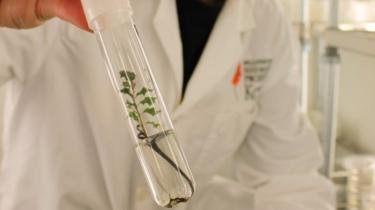
A tiny oak tree emerges from a test tube in the laboratory.
The seedling of the mighty oak has had an unusual start in life.
Raised using techniques pioneered in fertility labs, it is the product of new efforts to preserve the seeds of wild plants.
The world is losing plants at an unprecedented rate, with about one in five thought to be at risk of extinction.
"It's an insurance policy against extinction in the wild," says Dr John Dickie of Kew's Millennium Seed Bank at Wakehurst in West Sussex.
ADVERTISEMENT
"In situ conservation, in a reserve, is always the best, because then evolution can happen all the time. This is a very cost-effective back-up in case that system fails."
Oak treeImage copyrightGETTY IMAGES
Image caption
Oak tree in the countryside
As a back-up in the event of doomsday scenarios such as war, seeds of crops and wild plants are being stored in bomb-proof, flood-proof, radiation-proof vaults.
The goal is to store at least 75% of threatened plant species by 2020.
But new predictions suggest this is unlikely to be achieved, because many seeds cannot be stored using conventional means.
According to models published in the journal Nature Plants, 36% of critically endangered plant species, 33% of all trees and about 10% of medicinal plants fall into this category.
"Not all the plant species can be banked in the way of dried seeds in the freezer like we do in the seed bank," says Daniel Ballesteros, who works on cryopreservation at the Millennium Seed Bank.
"For example, we have the oaks and the chestnut that have desiccation-sensitive seeds and if we dry them, we kill them."
Researchers are investigating techniques such as cryopreservation for these hard to store seeds, which include staples such as coffee, chocolate and avocados, as well as heritage trees like the oak.
CryopreservationImage copyrightROYAL BOTANIC GARDENS KEW
Image caption
Cryopreservation relies on freezing plant embryos
Cryopreservation involves removing the plant embryo from the rest of the seed, then freezing it at very low temperatures in liquid nitrogen.
In this way, trees such as the oak can be stored for the future.
Hi! I am a robot. I just upvoted you! I found similar content that readers might be interested in:
https://www.bbc.co.uk/news/science-environment-46065156
Downvoting a post can decrease pending rewards and make it less visible. Common reasons:
Submit